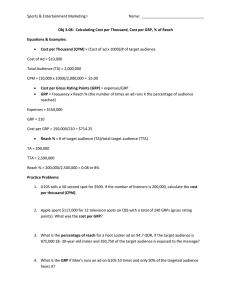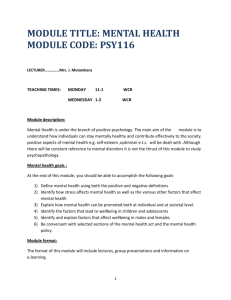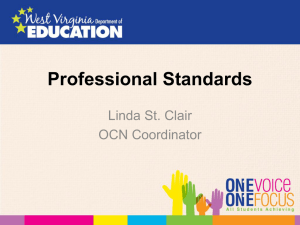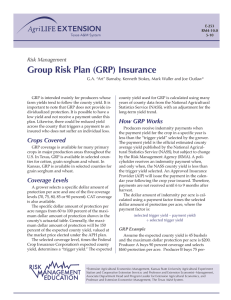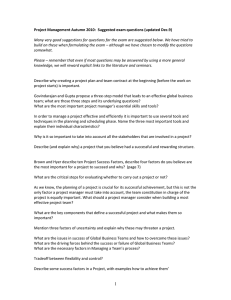Group Risk Plan
advertisement
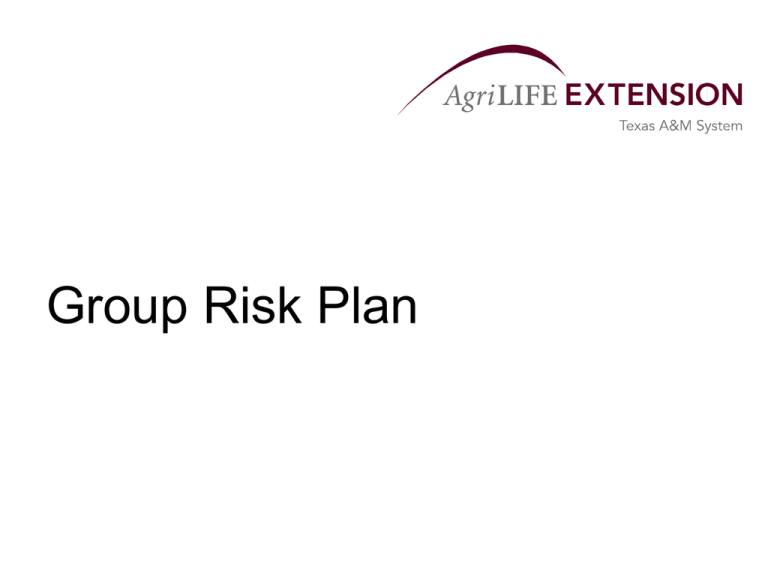
Group Risk Plan Group Risk Plan Departure from traditional approaches Insure county yields Requires less paperwork Cost may be less than basic APH Is GRP a Good Choice for You? Do your yields follow county yields? Is it available? Crops/counties Do you lack production records? Crops Covered GRP coverage is available for many primary crops in major production areas throughout the U.S. In Texas, GRP is available in selected counties for cotton, grain sorghum and wheat. In Kansas, GRP is available in selected counties for grain sorghum and wheat. Selecting Coverage Amounts Dollar amount per acre 60-100 percent of maximum from county actuarial table Maximum coverage Trigger Yield Select a coverage level at (70, 75, ….90) percent of expected average Trigger = coverage level times expected average yield Indemnity Payments Only if trigger yield > payment yield Indemnity payment = dollar coverage per acre x payment factor x number of acres covered Payment factor = trigger yield – payment yield trigger yield GRP Example Assume the expected county yield is 45 bushels and the maximum dollar protection per acre is $200. Producer A buys 90 percent coverage and selects $160 protection per acre. Producer B buys 75 percent coverage and selects $185 protection per acre. Both producers have 100 percent share in the crop and both plant 200 acres of the crop in the county. The unsubsidized premium rates for 75 and 90 percent coverage are $3.30 and $6.14 per hundred dollars of protection, respectively. The subsidized premium rates for 75 and 90 percent coverage are $1.35 and $3.01 per hundred dollars of protection, respectively. A’s “trigger yield” is 40.5 bushels per acre (90 percent of 45). A’s policy protection is $32,000 ($160 x 200 acres). The premium for A’s policy is $963, which is the total premium of $1,965 ($160 x $6.14 x 200 acres x .01) less the federal subsidy of $1,002 (total premium of $1,965 x 51 percent subsidy rate). B’s “trigger yield” is 33.8 bushels per acre (75 percent of 45). B’s policy protection is $37,000 ($185 x 200 acres). The premium for B’s policy is $500, which is the total premium of $1,220 ($185 x $3.30 x 200 acres x .01) less the federal subsidy of $720 (total premium of $1,220 x 59 percent subsidy rate). Group Risk Plan Subsidies and Fees Coverage Level CAT 70% 75% 80% 85% 90% Trigger yield 29.3 31.5 33.8 36.0 38.3 40.5 Unsubsidized rate 2.14 2.64 3.30 3.91 4.87 6.14 GRP premium subsidy 1.00 0.59 0.59 0.55 0.55 0.51 Fee $300 $30 $30 $30 $30 $30 GRP Advantages GRP is a simple way to manage risk GRP often provides the lowest cost production against widespread crop losses GRP requires significantly less paperwork Insurable acreage is acreage planted on or before the acreage reporting date There is wider range of coverage levels GRP reduces fraudulent claims There is limited adverse selection or moral hazard. Premium rates are based on historical county yields The program gives producers an additional risk management tool A farmer with several crop losses in a row may have better coverage with GRP than APH because of the reduced program yield GRP works well for large farming operations that have land widely dispersed throughout the county GRP Disadvantages GRP provides almost no coverage for any peril that is site specific GRP indemnity payments are not made until the following crop year, normally 6 to 9 months after harvest Lenders may not accept GRP as collateral GRP is not suitable for farmers whose yields do not follow the county yield Farmers cannot buy a combination of GRP and other RMA reinsured APH type coverages GRP provides no coverage for prevented planting GRP provides no coverage for quality losses

